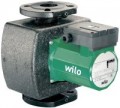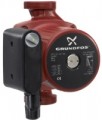Pump type
—
Centrifugal. As the name suggests, this type of pump uses centrifugal force. Their main element is the impeller installed in a round casing; the inlet is located on the axis of rotation of this wheel. During operation, due to the centrifugal force that occurs during the rotation of the wheel, the liquid is thrown from the centre to its edges and then enters the outlet pipe directed tangentially to the circle of rotation of the wheel. Centrifugal pumps are quite simple in design and inexpensive, while they are reliable and economical (due to high efficiency), and the fluid flow is continuous. At the same time, the performance of such units can drop with high resistance in the circuit.
—
Vortex. Vortex pumps are somewhat similar to centrifugal pumps: they also have a round casing and an impeller with blades. However, in such units, the inlet and outlet pipes of the working chamber are directed tangentially to the wheel, and the blades differ in design. The method of operation is also fundamentally different — it uses the vortices formed on the wheel blades. Vortex units are significantly superior to centrifugal units in terms of pressure, but they are sensitive to contamination — even small particles entering the impeller can cause damage, significantly reducing efficiency. And the efficiency of vortex pumps is low — 2-3 times lower than that of centrifugal pumps.
Max. flow
The maximum flow of a pump is the amount of liquid it can pump in a certain amount of time.
Features of choosing the optimal performance option depend primarily on the purpose of the pump (see above). For example, for DHW recirculation models, the pump performance should not exceed the performance of the water heater. If the water heater is capable of delivering 10 litres per minute to the DHW circuit, then the maximum pump performance will be 10*60=600 L/h. The basic formula for calculating the performance of a heating system takes into account the power of the heater and the temperature difference at the inlet and outlet, and for the cold water system — the number of points of water intake. More detailed information about the calculations for each application can be found in special sources, and it is better to entrust the calculations themselves to professionals.
Max. head
The head can be described as the maximum height to which a pump can lift liquid through a vertical pipe without bending or branching. This parameter is directly related to the pressure that the pump produces: 10 m of head approximately corresponds to a pressure of 1 bar (do not confuse this parameter with operating pressure — see more about it below).
The head is one of the key specs for most circulation pumps. Traditionally, it is calculated based on the difference in height between the location of the pump and the highest point of the system; however, this principle is relevant only for units that
boost the pressure of cold water(see "Suitable for"). Circulation pumps for heating and DHW work with closed circuits, and the optimal pressure depends on the total hydraulic resistance of the system. Detailed calculation formulas for the first and second cases can be found in special sources.
Minimum fluid temperature
The lowest fluid temperature at which the pump is capable of operating normally.
Almost all pumps can normally transfer cool water, regardless of the purpose (see above); therefore, for normal household use, this parameter is not critical and for some models, it may not be indicated at all. But if you need the ability to work with liquids with temperatures below 15 °C, you should pay close attention to the minimum temperature. Some models that can be used with antifreeze normally tolerate even temperatures below zero.
Max. fluid temperature
The highest liquid temperature that the pump is capable of operating normally.
The possibility of using the unit directly depends on this parameter (see "Suitable for"): for example, models for heating systems must tolerate a temperature of at least 95 °C, and for DHW supply — at least 65 °C. Well, anyway, this parameter should not be exceeded: an overheated pump will fail very quickly, and the consequences of this can be very unpleasant.
Max. power consumption
The electrical power consumed by the pump during normal operation and maximum performance.
This indicator directly depends on performance — after all, for pumping large volumes of water, an appropriate amount of energy is needed. And the power depends on two main parameters — electricity consumption and the load on the power grid, which determines the connection rules. For example, pumps with a power of more than 5 kW cannot be connected to ordinary household sockets; more detailed rules can be found in special sources.
Mains voltage
Operating voltage for which the pump is designed.
— 230 V. Standard voltage of household networks. Most of these pumps can be powered from a regular outlet, which makes them very convenient to connect. At the same time, this option is not well suited for creating high-performance units — already with a power consumption of more than 5 kW, certain tricks in connection will be required, and in general, 230 V provide less power than 400 V. Therefore, the such power supply is typical mainly for models elementary and intermediate levels.
— 400 V. This option implies power supply from three-phase networks with a voltage of 400 V. Such networks are rarely found in everyday life, but they are widely used in the professional field, including at industrial facilities — they are convenient for powering high-power equipment. Therefore, three-phase power is usually provided in professional high-performance pumps.
Country of brand origin
In this case, the country of origin refers to the country from which the product brand originates. A brand, in turn, is a general designation by which the products of a particular company are known in the market. The country of its origin does not always coincide with the actual place of production of the product: to reduce the cost of production, many modern companies transfer it to other countries. It is quite normal for products, for example, of an American or German brand, to be made in Taiwan or Turkey. Contrary to popular belief, this in itself does not lead to a decrease in the quality of the goods — it all depends on how carefully the brand owner controls the production. And many companies, especially large and famous ones, monitor the quality very zealously — after all, their reputation depends on it.
Protection class
It is an indicator that determines the degree of protection of dangerous (moving and current-carrying) parts of the hardware of the pump from adverse effects, namely solid objects and water. Since pumps, by definition, are used for pumping liquids, and many of them can normally pass quite large particles, in this case, we are talking about protection against moisture and objects from outside.
The level of protection is usually indicated by a marking of the letters IP ("ingress protection") and two numbers, the first of which indicates protection against the effects of solid objects, and the second — against the ingress of water.
For the first digit, each value corresponds to the following protection values: 1 — protection against objects with a diameter of more than 50 mm (large body surfaces) 2 — against objects with a diameter of more than 12.5 mm (fingers, etc.) 3 — against objects more than 2.5 mm (most tools) 4 — against objects larger than 1 mm (virtually all tools, most wires) 5 — dust-proof (total protection against contact; the dust can enter, but does not affect the operation of the device) 6 — dust-proof (case with full dust protection and contact).
For the second digit: 1 — protection against vertically falling drops of water 2 — against drops of water with a deviation of up to 15 ° from the vertical axis of the device 3 — against drops of water with a deviation of up to 60 ° from the vertical axis of the device (rain) 4 — again...st splashes from any direction 5 — from jets from any direction 6 — from sea waves or strong water jets 7 — short-term immersion to a depth of up to 1 m (without the possibility of continuous operation in immersed mode) 8 — long-term immersion to a depth of more than 1 m (with the possibility of permanent operation) in immersed mode).
In some cases, one of the numbers may be replaced by the letter X — this means that the official certification for the corresponding parameter has not been carried out. In pumps, X is usually put in place of the first digit, because a high degree of moisture resistance in itself means a high degree of protection against solid contaminants. At the same time, for such models, an additional letter index can be provided, which describes the degree of protection against specific solid objects — for example, IPX2D. The letter D corresponds to the highest degree of stability, which does not allow the wire to be hit; the previous options A, B and C respectively mean protection from the hand, from the finger and a small tool like a screwdriver.

